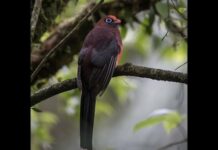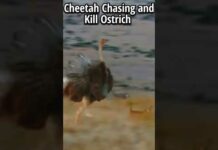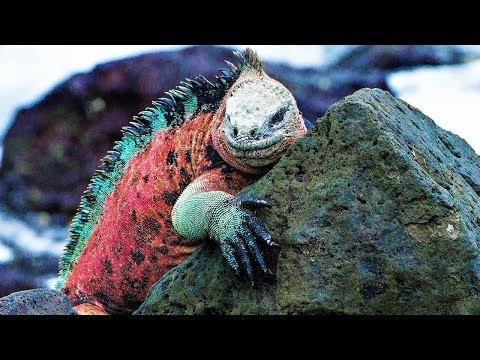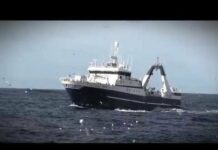From weird pink iguanas and painted insects; to mysterious new species; here are STRANGEST Creatures of the Galapagos Islands !
Galapagos Penguin
Native to the islands, this is the only penguin known to exist north of the equator in the wild. It’s one of the world’s smallest species of penguin at about 19 inches long and weighing some 5.5 pounds. And due to its low population it’s also considered one of the rarest penguin species. Including other factors, the birds have many predators, including introduced species like dogs and rats. When they’re in the water, sharks and sea lions target the penguins.
Marine Iguanas
Charles Darwin was not impressed with their looks and called them ‘imps of darkness’. They’re better known as marine iguanas that are found only on the Galapagos Islands … and are the only sea-going lizard currently known. Some of their marine adaptations include the ability to dive for more than 60 feet, and stay submerged for a hour. Marine Iguanas normally subsist on seaweed. But when food gets low, experts say they can somehow shorten their own bones to make them smaller, and more energy efficient. Their dark coloration serves a couple of purposes. While it allows them to blend in with their environment, it also helps them quickly absorb heat after swimming in the cold waters.
Blue Footed Booby
It’s pretty easy to guess where this marine bird gets its name. While those feet look strange, they do serve a vital purpose when it comes to perpetuating the species. Males will strut around females, lifting their feet up and down in an unusual mating ritual. The guys with the brightest feet indicate greater fertility, and will usually win the ladies. Because the color fades with age, females mate with the younger males. The blue coloration is a result of a pigment the birds absorb from their diet of fresh fish. Unlike some of the critters on the list, these birds are not found only in the Galapagos … but experts say that about half of their global population breeds there.
Galapagos Pink Land Iguanas
There’s only one place in the world … and only one location in the Galapagos where you can see these uniquely colored lizards. In fact, the pinkish hue almost makes you wonder if this isn’t yet another one of those digitally created beasts … either that, or the reptile seems to have had its dark skin scraped off, leaving it pink and raw. But that is their natural coloration. If you want to see one in the pink flesh, they’re found in the Volcan Wolf region of the Galapagos, on Isabela Island. While this iguana is a species unto itself, experts say only around 100 of them known to exist.
And before getting to the number one critter, here’s an honorable mention. We found an interesting story about the Great Frigatebird which nests in the Galapagos. It’s not unlike the Magnificent Frigatebird which we mentioned earlier. In this species, the males also have a red sac at the throat which is inflated to attract a mate. We’re including it because this particular animal was involved with an unusual experiment to see if birds could actually sleep while flying. And while that has been suspected for some time, scientists now have proof of the phenomenon. The brainwaves of Great Frigatebirds were monitored for 10 days. Researchers found that the birds could in fact be half asleep, but kept one eye open (literally) to watch out for potential threats. The stats revealed that the bird subjects would sleep for just over 40 minutes while they flew on autopilot. But when on land, they will sleep for up to 12 hours a day. Experts say it’s an example of ‘unihemispheric sleep’ — where one half of the brain shuts down while the other half remains alert.
Galapagos Tortoises
The world’s largest species of tortoise can weigh more than 900 pounds. That enormous size has helped make them so iconic, that the Galapagos Islands were actually named after these reptiles (not the other way around). They’re among the longest lived invertebrates, with life spans documented up to around 170 years. Their population underwent a great decline from when they were first found in the 16th century. At that time their population numbered around 250,000 individuals. By the 1970s, only 3,000 existed. Today, there’s around 25,000, but the species is classified as vulnerable. Besides the Galapagos, Giant Tortoises only exist on the archipelago of Aldabra in the Indian Ocean.
From pink iguanas and painted insects to birds with blue feet here at amazing creatures found in the Galapagos Islands hey some comments coming in from Italy with some nice words there indeed so thanks for riding in Kona tempted to ask if you live up to your name but no worries that gratzi all the same Cheers number 18 Sallie Lightfoot's.
While these colourful crustaceans are commonly found along the western coast of the Americas populations of them can also be found in the Galapagos the flat carapace usually measures a little over three inches and they typically feed on algae the Galapagos crabs have been observed engaging in some apparent symbiotic activities with local marine.
Iguanas to the crustaceans will clean ticks from the surface of the lizard skin and thanks to the brilliant coloration the crabs are often targeted by photographers visiting the area large painted locusts insects can be native to the Galapagos as well and these brightly colored critters can grow.
To around 8 centimetres long because the locusts serve as main prey for the galapagos hawk and the larvae lism they play a vital role in the food chain in the archipelago galapagos marking bed there are four species of this bird found in the Galapagos Islands and while it may not have the same name recognition of darwin's finches the.
Mockingbird was the creature first found by Darwin that displayed unique adaptive differences from one island to another they're sometimes compared to Roadrunners because they're known to hunt the prey by running after him galapagos hawk it's recognised as a large hawk in a top-flight predator.
While it often preys on smaller critters like locusts and lizards this bird has been known to go after iguanas and the hatchlings of giant tortoises they have a four and a half foot wingspan and can weigh around three and a half pounds and they are the only de eronel Raptors that inhabit the islands meaning they operate through the die only some 150 mating.
Pairs of the birds are estimated to remain though the numbers have fallen due to hunting by humans and a diminishing selection of prime lava lizards while these creatures can be found in South America several species are native to the Galapagos the small lizards are noted for the great varieties of shapes sizes and colors and.
Which they can be found experts say it's an example of adaptive radiation or the way in which organisms rapidly diversify to adapt to changing environments like many such creatures the lizards are thought to have evolved from a single ancestral species magnificent frigate bird now here's a bird that can really puff out its chest during breeding.
Season the sac will inflate and expand to attract a mate the bride of the pouch the greater the chance of getting the female's attention in addition to the Galapagos Islands it's also found in the tropical Atlantic Wyles some huge marine mammals are known to take up residence in the Galapagos two of the largest the blue whale and.
The fin whale are commonly seen in the marine reserve others include humpbacks sperm whales and orcas or killer whales even though those critters are actually members of the dolphin family waved albatross at around nine pounds with a wingspan exceeding 8 feet this is the largest bird you'll find of the Galapagos Islands the known as.
Spectacular fliers able to fly long distances for hours without stalling even though they can have a great range the birds will only breed on the Galapagos did you know the name for the wave-like patterns found in the feathers of adult specimens dolphins these creatures are among the better known forms of marine life found.
In the Galapagos and that includes the bottlenose variety as well as the common dolphin in all five species are known to be found here but these two actually live in the Galapagos waters the other three pass through when migrating flightless cormorant all of these aquatic birds have powerful legs and webbed feet that propel them through.
Ocean waters in search of prey like eels and fish but only this species endemic to the Galapagos is known to have lost the ability to fly that makes it among the most unusual species to be found that it's also the heaviest species of cormorant lying around 11 pounds around 1,600 of these unique birds are thought to exist Darwin's finches these birds.
Are some of the most famous animals in the Galapagos Archipelago since they played a vital role in the development of Darwin's theory of natural selection the 13 species descended from a single ancestral species and they all display a remarkable variance in the shape and in the size of the beaks galápagos fur seal one of the few mammals that are native.
To the archipelago this animal is the world's smallest eared seal more so than any other seal they spend most of the time on the land not in the water other species tend to have a 50/50 ratio in that regard with few predators they feed mainly on cephalopods and fish and form large colonies on the rocky shoreline shocks the world's biggest fish the.
Whale shark is known to frequent the waters of the Galapagos Islands at some 45 feet long and weighing around 47,000 pounds they would be pretty hard to miss other big fish in the area include hammerhead sharks and there is a species native to the archipelago called oddly enough the Galapagos shark they are known to be aggressive and are regarded.
As dangerous to humans growing around ten feet long they're a species of Requiem shark which are seen around the world galapagos penguin native to the islands this is the only penguin known to exist north of the Equator in the wild it's one of the world's smallest species of penguin at around 19 inches long and weighing some five-and-a-half.
Pounds and due to its low population it's also considered one of the rarest penguin species including other factors the birds have many predators including introduced species like dogs and rats when they're in the water sharks and sea lions target the Penguins marine iguanas a Charles Darwin himself was not so impressed with the looks and actually.
Called him imps of Darkness the better known as marine iguanas that are found only on the Galapagos Islands and they are the only seagoing lizard currently known some of that marine adaptations include the ability to dive for more than 60 feet and stay submerged for up to an hour marine iguanas normally subsist on seaweed but when food gets.
Low experts say they can somehow shorten their own bones to make them smaller and thus more energy efficient the dark coloration serves a couple of purposes while it allows them to blend in with the environment it also helps them quickly absorb heat after swimming in the cold waters.
Blue-footed booby now it's pretty easy to guess where this marine bird gets its name while those feet do look strange they serve a vital purpose when it comes to perpetuating the species males will strut around females lifting the feet up and down in an unusual mating ritual the guys with the brightest feet indicate.
Greater fertility and will usually win over the ladies because the color fades with age females meet with the younger males the blue coloration is a result of a pigment the birds absorb from the diet of fresh fish and unlike some of the critters on the list these birds are not found only in the Galapagos but experts say that about half of the global.
Population breeds their Galapagos pink land iguanas now there is only one place in the world and only one location in the Galapagos where you can see these uniquely colored lizards in fact the pinkish hue almost makes you wonder if it isn't yet another one of those digitally created beasts either that of the reptile seems to have had its dark.
Skin scraped off leaving it pink and raw but that is the natural coloration now if you want to see one in the pink flesh the found in the Vulcan Wolf region of the Galapagos on Isabella island while this iguana is a species unto itself experts say only around a hundred of them are known to exist and before getting to our number one critter here.
Is an honorable mention and we found an interesting story about the great frigate bird which nests in the Galapagos now it's not unlike the Magnificent frigate bird which we mentioned earlier in this species the males also have a red sock at the throat which is inflated to attract a mate now we're including it because this.
Particular animal was involved with an unusual experiment to see if birds could actually sleep while flying and while that has been suspected for some time scientists now have proof of the phenomenon the brainwaves of great frigate birds were monitored for ten days research has found that the birds could in fact be half asleep but kept.
One eye open literally to watch out for potential threats the start's revealed that the bird subjects would sleep for just over 40 minutes while they flew on autopilot but when unwind they'll sleep for up to 12 hours a day experts say it's an example of you hemispheric sleep that's where one half of the brain shuts down while the other.
Half remains Alette Galapagos Tortoises the world's largest species of tortoise can weigh more than 900 pounds and that enormous size has helped make them so iconic that the Galapagos Islands were actually named after these reptiles not the other way around they're among the longest lived invertebrates with life spans documented.
Up to around a hundred seventy years the population underwent a great decline from when they were first found in the sixteenth century however at that time the population numbered around 250,000 individuals by the 1970s only three thousand existed now today there's around twenty five thousand but the species is classified as vulnerable.
Besides the Galapagos giant tortoises only exist on the archipelago of Aldabra in the Indian Ocean
We are excited to present to you the captivating video titled “STRANGEST Creatures of the Galapagos Islands !”. Get ready to embark on a journey of enjoyment, smiles, and laughter as you watch this delightful creation. “STRANGEST Creatures of the Galapagos Islands !” is a perfect blend of entertainment and amusement, carefully crafted to bring joy to your day. From the moment you press play, you’ll be greeted with a cascade of lighthearted moments, heartwarming scenes, and perhaps even a few surprises that will tickle your funny bone.
Whether you’re in need of a quick pick-me-up or simply looking for some light-hearted entertainment, “STRANGEST Creatures of the Galapagos Islands !” has you covered. The video promises to deliver a collection of moments that are bound to leave you grinning from ear to ear. With its engaging content and skillful presentation, “STRANGEST Creatures of the Galapagos Islands !” is more than just a video – it’s an experience designed to brighten your mood and spread positivity.
The creators of “STRANGEST Creatures of the Galapagos Islands !” have poured their creativity and dedication into crafting a visual treat that resonates with audiences of all ages. Through expert storytelling, impeccable timing, and an array of engaging content, “STRANGEST Creatures of the Galapagos Islands !” promises to be an unforgettable journey that lingers in your memory long after the video concludes.
So sit back, relax, and prepare to be entertained as you dive into the world of “STRANGEST Creatures of the Galapagos Islands !”. It’s a delightful video that aims to bring a dose of happiness to your day, leaving you with a lasting smile and a heart full of laughter.
This video was uploaded in youtube and has recieved 146820 views so far. This is a great achievement and laso it has received 1422 likes and .
Data bout the video:
Rating: ,
Video dimensions: 2d,
Video definition: hd,
Video duration: 00:10:37,
Video favourite count: 0
Video comment count: 118























